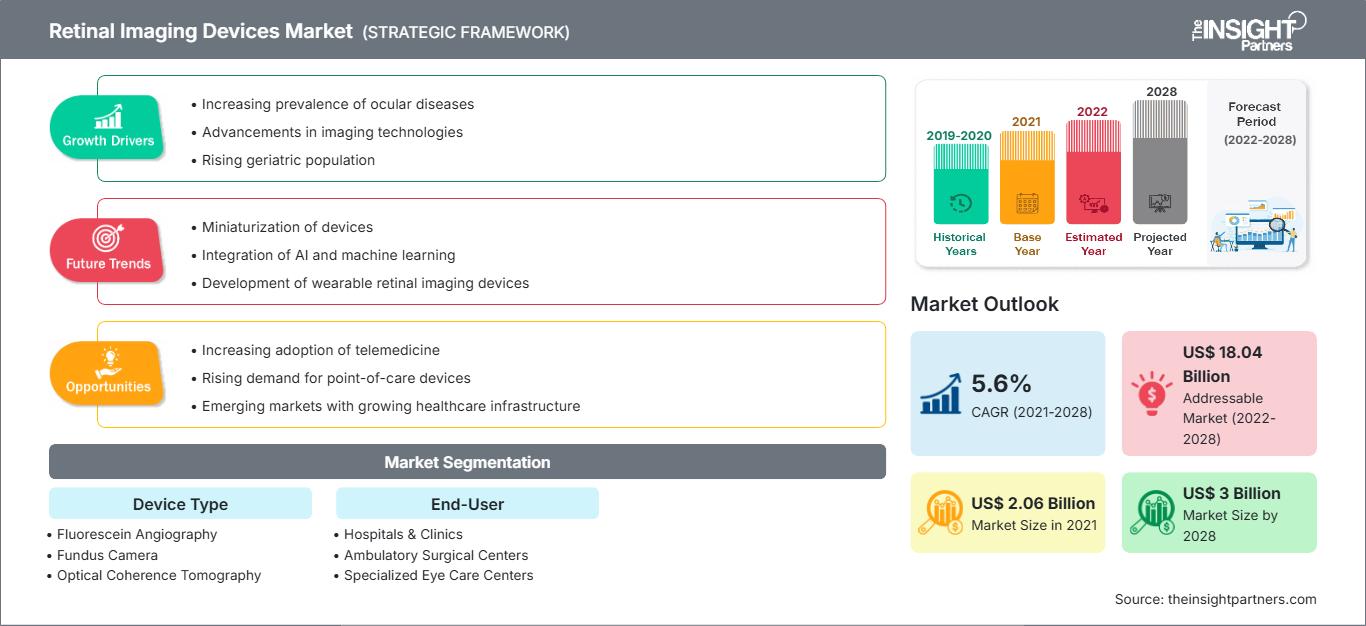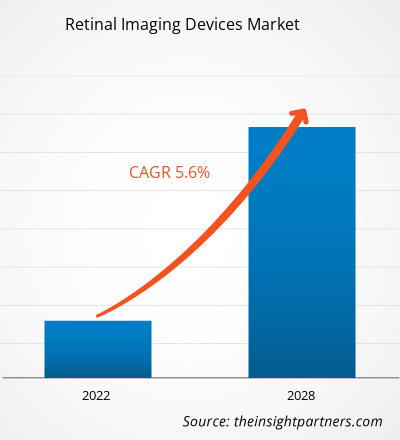Se proyecta que el mercado de dispositivos de imágenes de retina alcance los 3.000 millones de dólares en 2028, desde los 2.060 millones de dólares en 2021; se estima que crecerá a una CAGR del 5,6 % durante 2021-2028.
La imagenología retiniana es una técnica que se utiliza para analizar y diagnosticar el estado de la retina de un paciente. Los dispositivos de imagenología retiniana (RID) utilizan sistemas de imagen de alta resolución para capturar imágenes del interior del ojo. La imagen capturada ayuda a los médicos de redes privadas virtuales (VSP) a evaluar la salud de la retina, lo que facilita la detección y el tratamiento de afecciones oculares y de salud como la diabetes, el glaucoma y la degeneración macular, entre otras.
Personalice este informe según sus necesidades
Obtendrá personalización en cualquier informe, sin cargo, incluidas partes de este informe o análisis a nivel de país, paquete de datos de Excel, así como también grandes ofertas y descuentos para empresas emergentes y universidades.
Mercado de dispositivos de imágenes de retina: Perspectivas estratégicas

-
Obtenga las principales tendencias clave del mercado de este informe.Esta muestra GRATUITA incluirá análisis de datos, desde tendencias del mercado hasta estimaciones y pronósticos.
El crecimiento del mercado de dispositivos de imagenología retiniana se atribuye al mejor acceso de los oftalmólogos a la retina, al aumento de las iniciativas globales para la ceguera y a los avances tecnológicos. Sin embargo, el alto costo de los dispositivos de OCT frena el crecimiento del mercado.
Perspectivas del mercado
Aumento de la prevalencia de enfermedades oculares
Los dispositivos de diagnóstico por imagen de la retina se utilizan ampliamente para diagnosticar y tratar diversas enfermedades oculares, como la retinopatía diabética, la degeneración macular relacionada con la edad, el glaucoma, el melanoma ocular y los problemas de visión leves. Además, la preocupación por la ceguera o la discapacidad visual está creciendo significativamente a nivel mundial. Según datos publicados por la Organización Mundial de la Salud (OMS) en octubre de 2021, casi 2200 millones de personas viven con discapacidad visual o ceguera. De estos, aproximadamente mil millones de casos de discapacidad visual pueden prevenirse mediante un diagnóstico y tratamiento adecuados. Estos mil millones de personas presentan diferentes problemas oculares relacionados con la discapacidad visual moderada o grave o la ceguera. Las tecnologías de diagnóstico por imagen han comenzado a ofrecer un crecimiento sin precedentes en el ámbito de las enfermedades oculares basadas en conjuntos de datos morfológicos. Se espera que este factor impulse el mercado de dispositivos de diagnóstico por imagen de la retina durante el período de pronóstico.
Información basada en el tipo de dispositivo
Según el tipo de dispositivo, el mercado global de dispositivos de imágenes de retina se ha segmentado en angiografía con fluoresceína, cámara de fondo de ojo y tomografía de coherencia óptica. El segmento de la cámara de fondo de ojo tuvo la mayor participación del mercado en 2021. La fotografía de fondo de ojo ha evolucionado desde flashes electrónicos a cámaras para teléfonos inteligentes y, más recientemente, al kit de examen ocular portátil (PEEK). PEEK es una aplicación para teléfonos inteligentes que permite un examen ocular completo. La ventaja de estas cámaras es que una persona no oftalmóloga puede tomar imágenes y, con cierta capacitación, también calificarlas. Sin embargo, se anticipa que el segmento de tomografía de coherencia óptica registre la tasa de crecimiento anual compuesta (TCAC) más alta del mercado, del 8,1 %, durante el período de pronóstico. La tomografía de coherencia óptica permite la evaluación de diferentes niveles de isquemia macular que no se diagnostican en la imagen primaria. La técnica se utiliza como estándar para las modalidades de imagenología ocular.
Información basada en el usuario final
Según el usuario final, el mercado global de dispositivos de imagenología de la retina se segmenta en hospitales y clínicas, clínicas especializadas, centros de atención ambulatoria, entre otros. El segmento de hospitales y clínicas tuvo la mayor participación de mercado en 2021, y se espera que los centros de atención oftalmológica especializada registren la mayor tasa de crecimiento anual compuesta (TCAC) del mercado, del 6,6 % durante el período de pronóstico.
Perspectivas regionales del mercado de dispositivos de imágenes de retina
Los analistas de The Insight Partners han explicado detalladamente las tendencias y los factores regionales que influyen en el mercado de dispositivos de imagenología retiniana durante el período de pronóstico. Esta sección también analiza los segmentos y la geografía del mercado de dispositivos de imagenología retiniana en América del Norte, Europa, Asia Pacífico, Oriente Medio y África, y América del Sur y Central.
Alcance del informe de mercado de dispositivos de imágenes de retina
| Atributo del informe | Detalles |
|---|---|
| Tamaño del mercado en 2021 | US$ 2.06 mil millones |
| Tamaño del mercado en 2028 | 3 mil millones de dólares estadounidenses |
| CAGR global (2021-2028) | 5,6% |
| Datos históricos | 2019-2020 |
| Período de pronóstico | 2022-2028 |
| Segmentos cubiertos |
Por tipo de dispositivo
|
| Regiones y países cubiertos |
América del norte
|
| Líderes del mercado y perfiles de empresas clave |
|
Densidad de actores del mercado de dispositivos de imágenes de retina: comprensión de su impacto en la dinámica empresarial
El mercado de dispositivos de imagenología de la retina está creciendo rápidamente, impulsado por la creciente demanda del usuario final debido a factores como la evolución de las preferencias del consumidor, los avances tecnológicos y un mayor conocimiento de los beneficios del producto. A medida que aumenta la demanda, las empresas amplían su oferta, innovan para satisfacer las necesidades del consumidor y aprovechan las tendencias emergentes, lo que impulsa aún más el crecimiento del mercado.

- Obtenga una descripción general de los principales actores clave del mercado de dispositivos de imágenes de retina
Perspectivas regionales
Por regiones, América del Norte representó la mayor participación en 2021 y se espera que siga una tendencia similar durante el período de pronóstico. Se prevé que la región de Asia Pacífico registre la mayor tasa de crecimiento durante el período de pronóstico. Se espera que la aplicación de inteligencia artificial (IA) y sistemas de aprendizaje profundo (DLS) para mejorar la cobertura de detección en Singapur impulse el crecimiento regional durante los próximos siete años.
El lanzamiento y la aprobación de productos son estrategias comunes que adoptan las empresas para expandir su presencia global y su cartera de productos. Además, los actores del mercado de dispositivos de imagenología de la retina se centran en la estrategia de asociación para ampliar su clientela, lo que, a su vez, les permite mantener su marca a nivel mundial.
Según el tipo de dispositivo, el mercado de dispositivos de imagenología retiniana se clasifica en angiografía con fluoresceína, cámara de fondo de ojo y tomografía de coherencia óptica. Según el usuario final, el mercado se segmenta en hospitales y clínicas, centros de cirugía ambulatoria, centros de atención oftalmológica especializados y otros usuarios finales. Geográficamente, el mercado de dispositivos de imagenología retiniana se segmenta en Norteamérica (EE. UU., Canadá y México), Europa (Reino Unido, Alemania, Francia, Italia, España y el resto de Europa), Asia Pacífico (China, Japón, India, Australia, Corea del Sur y el resto de Asia Pacífico), Oriente Medio y África (Emiratos Árabes Unidos, Arabia Saudita, Sudáfrica y el resto de Oriente Medio y África), y Sudamérica y Centroamérica (Brasil, Argentina y el resto de Sudamérica y Centroamérica). Algunas de las empresas incluidas en el alcance de nuestra investigación son Carl Zeiss Meditec, Revenio Group Oyj, Nikon Corporation, Optomed, Topcon Corporation, Imagine Eyes, Epipole Ltd, Forus Health Pvt Ltd, Eyenuk Inc y Phoenix Technology Group LLC, entre otras.
- Análisis histórico (2 años), año base, pronóstico (7 años) con CAGR
- Análisis PEST y FODA
- Tamaño del mercado, valor/volumen: global, regional y nacional
- Industria y panorama competitivo
- Conjunto de datos de Excel
Informes recientes
Testimonios
Razón para comprar
- Toma de decisiones informada
- Comprensión de la dinámica del mercado
- Análisis competitivo
- Información sobre clientes
- Pronósticos del mercado
- Mitigación de riesgos
- Planificación estratégica
- Justificación de la inversión
- Identificación de mercados emergentes
- Mejora de las estrategias de marketing
- Impulso de la eficiencia operativa
- Alineación con las tendencias regulatorias






















 Obtenga una muestra gratuita para - Mercado de dispositivos de imágenes de retina
Obtenga una muestra gratuita para - Mercado de dispositivos de imágenes de retina